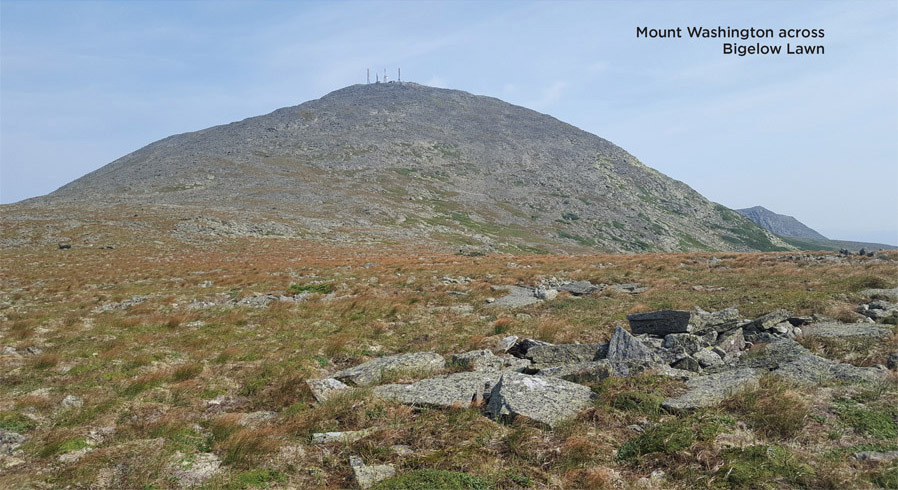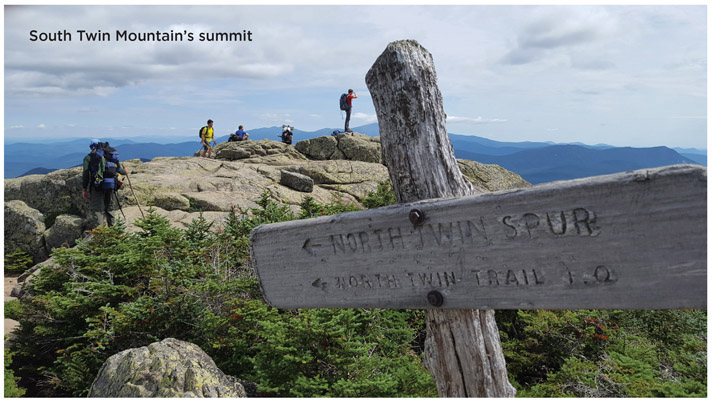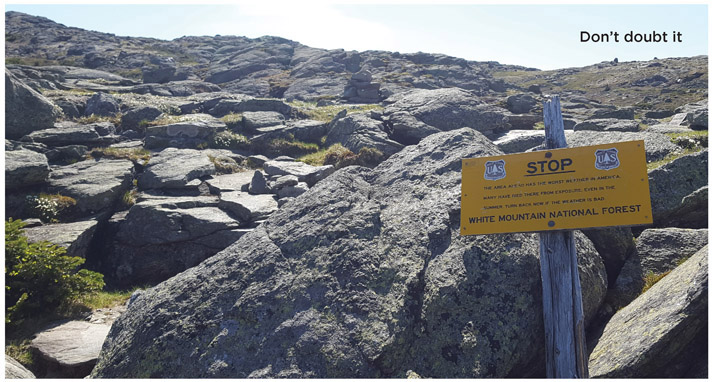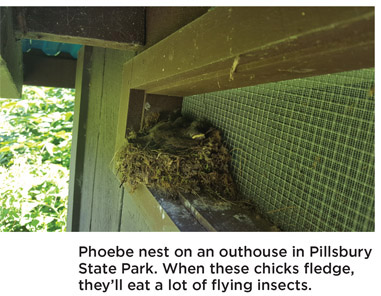A BRIEF HISTORY OF HIKING IN NEW HAMPSHIRE
NEW HAMPSHIRE HAS A LONG HISTORY of recreational hiking and mountain climbing. Darby Fields ascent of Mount Washington in 1642 is the earliest. Field evidently climbed the mountain in an attempt to locate Lake Champlain for the Laconia Company, which wanted to establish fur trade with the Native Americans living there. Fields climb was aided by two Indian guides and local Natives living in what is today Glen.
The next well-known ascent of Washington was by the Belknap-Cutler expedition in 1784. Like many of those who followed for the next hundred years, this expedition was scientific, not recreational. Recreational use of the White Mountains really begins with the Crawford family and the inns they established. Other mountains around New Hampshire had their own inns that drew tourists, hikers, and climbers. Even so, the expedition led by state geologist Charles Hitchcock from 1869 to 1872 made numerous first ascents.
The Appalachian Mountain Club (AMC) was established in 1876. This really marked the beginning of serious recreational hiking and peak bagging in New Hampshire. Eventually, summer and year-round residents in many towns established clubs that built and maintained trails in their home mountains. This tradition continues today. Many wonderful hikes in New Hampshire are possible because of local support and trail builders.
LISTING
Peak bagging in the Northeast began in the early 20th century in the Adirondacks. Nathaniel Goodrich, a Dartmouth librarian, is credited with bringing the idea to New Hampshire. In December 1931, he published an article in AMCs journal Appalachia with a list of the thirty-six 4,000-footers in New Hampshire. The race was on to be the first to climb them all. Over time, the criteria for the list evolved and trails built to more peaks. Today, there are officially forty-eight mountains on the list [see Appendix A].
Peak bagging, too, has evolved. For many, its not enough to climb all the 4,000-footers and earn your badge. Now people do all of them in winter or in a specific period of time. Recently, gridding has become popular. To grid the list, you have to climb each of the forty-eight 4,000-footers in each of the 12 months of the yearthats 576 summits.
Others have created different lists. The Terrifying 25 is a list of the most harrowing hikes in the White Mountains [see Appendix C]. The 52 with a View is a list of fifty-two hikes less than 4,000 feet with outstanding views. This list was started by the Over the Hill Hikers to draw people to lesser-known mountains in New Hampshire [see Appendix B].
Other lists include hikes outside New Hampshire. They include the New England 100the one hundred highest mountains in New England; the Northeast 111which includes all the 4,000-footers in New England and New Yorks Adirondacks; and the New England 4,000-Footersthe list of sixty-seven 4,000-footers in New Hampshire, Vermont, and Maine.
For the average hiker, listing has had two important impacts. First, hikes on one of the lists (especially a 4,000-footer) are likely to be more crowded than they otherwise would be. For example, Mount Tecumseh in Waterville Valley is going to be more crowded than nearby Sandwich Dome, which is 40 feet short of 4,000 feet, even though the Sandwich Dome hike has much better views and is more interesting. Second, hikes on the list see a lot of winter traffic. As a result, the trails get packed down, making many of them easily accessible year-round even without snowshoes. It also means these trails remain snowand ice-covered longer than other trails and longer than the woods they pass through. Both of these are things to consider when planning your hikes.
BEFORE YOU GO
New Hampshire has little wildlife that presents any danger to hikers. The greatest danger to most hikers is lack of preparation. Know your limits, and hike your own hike. No matter how experienced or aerobically fit you are, theres going to be someone on the trail better and faster. Dont worry about it. Start slow and build to the more challenging hikes. Respect the woods. Use common sense.
To help with this, each hike description lists distance, difficulty, and elevation gain. The elevation gain listed is the total climbing for the hike, not simply the difference between the trailhead and high point on the trail. Use this information to plan the hike thats right for you and the days conditions. Other factors influence when and how to approach a hike; they include weather, bugs, and access rules.
WEATHER
Any weather is good hiking weather, but some days are better than others. Ideally, the temperature would be in the 50s with low humidity. Looked at that way, spring and fall are the best times to hike. The trick isnt to wait for ideal conditions, but to choose a hike well-suited to the weather. If the clouds are low and threatening, hike in a valley or to a waterfall. If it rained last night and the air is scrubbed clean, head for a mountaintop with expansive views. But sometimes its fun to hike in the dampened, soft embrace of a cloud. The world is still and sounds muffled. Usually, you have the trail to yourself.
Its important to try out every season and all types of weather. You just have to use common sense and bring the right gear. Dont hike above treeline if lightning is likely. Dont plan to climb a slide when its raining. Dont climb Mount Washington on a bluebird day just to be one of the hundreds on the summit.
The weather, especially in the mountains, is likely to be changeable and different at the trailhead and summit. You should always have a jacket or shell in your pack. Wear layers, so you can put on and take off clothes to meet the ever-changing conditions. And dont wear cotton. Cotton may be comfortable when its dry, but when it gets wet from rain or sweat, it pulls warmth from your body. Cotton also dries slowly. Remember, hypothermia often occurs at temperatures above freezing. Cotton often contributes.
Its usually a good idea to check the local weather conditions before you hike. There are several good online sources, including the AMCs local weather page (http://amc-nh.org/resources/weather.php).
BUGS
One theory holds that northern New England is sparsely populated because of the black flies. They can be quite a nuisance, leaving a hiker bleeding and scratching for days. Black flies begin to emerge in southern New Hampshire in early May. These adult flies overwinter in relatively warm places like hollow logs and leaf litter on the forest floor. When the weather warms enough for them to become active, theyre hungry. Their emergence rolls north through May. By the end of the month, theyre mobbing hikers atop the Presidentials. Black flies are only active during the day and outside (for some reason, when they come in a house, tent, or car, they try to escape rather than find someone to bite).
Mosquitoes are active pretty much any time of the year if the temperature is above freezing. They breed in standing water, so tend to be worst around bogs and ponds. Between the mosquitoes, black flies, deer flies, and other biting insects, it sometimes feels like the woods are out to get you.





